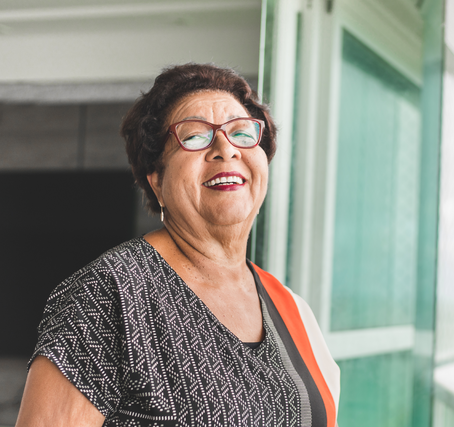Senate Hearing on Affordable, Accessible Housing for Older Adults
“In 2017, before the pandemic, five million older adult households spent more than half their incomes for housing. With less money left after housing costs each month, it’s too expensive for older renters and homeowners to do the renovations and modifications they would need to keep their homes safe and affordable – things like adding a ramp or grab bars or weatherizing to safe on heating bills,” Senate Committee on Banking, Housing, and Urban Affairs Chair Sherrod Brown (D-OH) said as he opened his Committee’s March 31 hearing, “Affordability and Accessibility: Addressing the Housing Needs of America’s Seniors.”
LeadingAge is grateful for Chair Brown’s strong leadership on affordable housing issues and for holding the March 31 hearing on affordable and accessible housing needs of older adults.
“Only 10% [of homes] are accessible to people with mobility challenges that come with age. If your home isn’t safe and you can’t afford to make it safe, sometimes seniors have no choice but to go to a nursing home. It’s often more expensive and may be more care than they want or need. The challenges faced by seniors today shouldn’t be a surprise. We’ve been watching baby boomers age for decades and we’ve really done nothing that meets the scale of this change,” Chair Brown said.
Senator Robert Menendez (D-NJ) noted Urban Institute projections for household formation. “According to the Urban Institute, of the 16.1 million new household formations overt the next 20 years, more than 80% of them will be senior households. Due to lack of affordable housing options and lasting damage from the financial and COVID crises, many of these senior households will be renters. What does this significant increase of senior households mean for our senior [HUD] housing capacity and the senior housing needs that Congress should prepare for?,” Senator Menendez asked hearing witness Jennifer Molinsky, Project Director, Housing an Aging Society Program, Joint Center for Housing Studies of Harvard University.
“Only 36% of our older adults receive the affordable housing assistance that they’re income-eligible for,” Ms. Molinsky said. “We’ll see increased demand for HUD programs. Programs like Section 202 and Project-Based Rental Assistance, which provide services as well, which are going to be increasingly important.”
“HUD’s Section 202 Housing for the Elderly program provides senior w affordable housing options and service coordinators to connect them with additional services and supports to age in place, which is far less costly to us than the alternatives. However, the program has been severely underfunded for under a decade. In 2010, Congress appropriated more than $450 million for the construction of new Section 202 homes. The final FY22 omnibus only provided only $199 million. That’s enormous when the population is going up and we’re going in the opposite direction. I’ve strongly advocated for more robust funding in years past and I hope my colleagues will join me in calling for enough funding to meet the rising needs of older Americans,” Senator Menendez said.
Senator Menendez has long led a Senate letter to Senate appropriators to urge more funding for HUD’s Section 202 Supportive Housing for the Elderly program. For FY22, the letter called on Congress to provide $600 million for new Section 202 capital advances and operating subsidy for new Section 202 homes, the same amount advocated for (in FY22 and again for FY23) by LeadingAge. Senator Menendez will lead this letter again this spring for FY23 funding and advocates will be encouraged to ask their Senate offices to join the letter.
“HUD’s Section 202 Housing for the Elderly program provides senior with affordable housing options and service coordinators to connect [older adult residents] with additional services and supports to age in place, which is far less costly to us than the alternatives. However, the program has been severely underfunded for under a decade. In 2010, Congress appropriated more than $450 million for construction of new Section 202 homes. The final FY22 omnibus only provided only $199 million. That’s enormous when the population is going up and we’re going in the opposite direction,” Senator Menendez said during the hearing. “I’ve strongly advocated for more robust funding in years past and I hope my colleague will join me in calling for enough funding to meet the rising needs of older Americans. Aging in place at the end of the day is far more dignified and far less costly to us as a society. The shortage of affordable housing is crushing our seniors. In my home state of New Jersey, one Section 202 provider has waiting lists eight to 10 years long to get into their communities. With waiting lists that long, the sad reality is that some seniors will never have the opportunity to benefit from that critical program.”
“Aging in place at the end of the day is far more dignified and far less costly to us as a society. The shortage of affordable housing is crushing our seniors. In my home state of New Jersey, one Section 202 provider has waiting lists eight to 10 years long to get into their communities. With waiting lists that long, the sad reality is that some seniors will never have the opportunity to benefit from that critical program,” Senator Menendez said.
Several other Committee Senators also participated in the hearing to comment on their state’s need for affordable, accessible senior housing and their support for it. Subcommittee on Housing, Transportation, and Community Development Chair Tina Smith (D-MN) and Senators Jon Osoff (D-GA), Kyrsten Sinema (D-AZ), Chris Van Hollen (D-MD), John Warner (D-VA), and Elizabeth Warren (D-MA) all expressed concern about the lack of affordable, accessible housing for older adults and the experiences of older adults who need such housing but do not have it. To the latter question, hearing witnesses responded that older adults who cannot access affordable housing because there is not enough of it pay less than their non-housing cost burdened peers for out-of-pocket medical costs, food, and transportation; put less away for retirement; double up; move frequently; spend more than half of their incomes for housing; live in severely substandard housing; and experience, at an increasing rate, homelessness.
“We urge Congress to strengthen the Section 202 and Section 8 programs, invest in public housing and supportive services, and urge more rigorous enforcement of the Fair Housing Act and the restoration of the Affirmatively Furthering Fair Housing rule, loss mitigation for reverse mortgage borrowers and federal incentives to spur local and state zoning reform,” witness Shannon Guzman, MCP, Senior Strategic Policy Advisor, AARP Public Policy Institute, said.
In her written testimony, Ms. Guzman referred to the Section 202 program as “crucially important. “The Section 202 Supportive Housing for the Elderly program represents a critically important housing solution for very low-income older adults. The 202 program is the only federally-funded, new construction housing program specifically designed to address the physical frailties of elderly residents and that aims to help people age well in their community,” the written testimony says.
Senator Ossoff noted that one quarter of the approximately 300,000 Georgians who spend more than half of their income on housing are seniors. “Across the state, I hear from seniors, from community leaders, from elected officials about the acute housing shortage faced by seniors in Georgia,” Senator Ossoff said.
Senator Ossoff also lamented the closing of some affordable assisted living communities in Georgia. Senator Ossoff said he frequently hears about “how the difficulties of operators of assisted living face in sustaining their business models can pose dire challenges for seniors seeking housing. In one facility in Acworth, Georgia, seniors were given just three days’ notice to vacate before the senior facility closed. The senior assisted living facility in Camden County, Georgia, closed last summer giving residents just 30 days to find a new place to live. Why is it so difficult for senior housing provider to stay in business?,” the Senator asked. LeadingAge is following up with the Senator’s office on his question.
“What is the single most important driver of homelessness?,” Senator Ossoff asked. “Housing costs,” Ms. Molinsky replied.
“We have an obligation to ensure that all seniors can retire with dignity and respect. They’ve worked incredibly hard and deserve to enjoy their golden years with friends, family, and loved ones. However, far too many seniors in Arizona struggle to find affordable housing. Seniors are among the most vulnerable to rising process and rent increases. This year, Arizona was short about 270,000 housing units. The high levels of demand far outpace the supply of housing units, which has accelerated the cost of rent,” Senator Sinema said.
“What are some of the most common barriers to allow seniors to age at home?,” Senator Sinema asked. Ms. Molinsky replied. “Affordability is a major one and the housing instability it brings. The majority of older adults live in single family homes, which are among the least accessible kind of housing. Less than 1%, a very miniscule amount, is fully wheelchair accessible should that be needed. Investing in housing to make it more accessible can be very challenging. The connections in the community can be a challenge – the issues with isolation and loneliness, the services and supports in the home too. People need these services more and more. There is a huge gap for services at the bottom of the income spectrum but also for middle income people who can’t afford assisted living who will need services in their homes,” Ms. Molinsky said.
“How is HUD housing with regard to accessibility?,” Senator Sinema asked. “We found that HUD housing offers more accessibility than market rate housing, but still less than 20% of HUD units have basic accessibility features like single floor living, no step entrance, grab bars in the bathroom. We think that 35% could be more accessible with relatively simple investments. So, HUD housing is more accessible than what you’d find in the private market but more is needed, particularly given the growth of the older population,” Ms. Molinsky responded.
Senator Sinema also raised homelessness among older adults. “We are seeing a rise in homelessness in Arizona, including among our seniors. We have a safety net in place for people experiencing homelessness but it is strained and it lacks resources. I also think that one challenge with the way we’ve designed the safety net is that it often assumes that individuals who use the safety net can eventually return to work and build wealth to achieve financial independence. This is not possible for many seniors. So many [older adults] exhaust their eligibility for benefits without finding a viable financial path forward.
“Thank you to all of you for your testimony today and talking about all the different elements that impact on the shortage of affordable housing for our seniors,” Senator Van Hollen said. “Clearly the supply side is a big issue. A number of you have also mentioned the reality that seniors also need to be able to connect to services if they don’t want to go into a more restrictive setting; this is a key component. If you look at the Section 202 Supportive Housing for the Elderly program that’s designed to try to provide the services, but only about half of the individuals in that program are able to access them. The funding is not sufficient. These individuals who may otherwise be able to use Section 202 housing but also have some services needs may be pushed into more restrictive and higher cost settings. The supportive services side, helping people age in place – what happens when they’re not available?.”
Ms. Molinsky noted that Service Coordinators are limited and they are “incredibly beneficial.” Senator Van Hollen was referring to the fact that only 45% of HUD-assisted multifamily senior housing has a Service Coordinator. LeadingAge is following up with Senator Van Hollen about the need for more Service Coordinators in HUD-assisted housing.
“We’ve seen rents go up and an increasing shortage of housing supply and we want to increase the amount of housing supply. How does President Biden’s budget address the housing supply issue and are there other things we should be looking at?,” Senator Warner asked the panel. Senator Warner also discussed the racial wealth gap. “A lot of [wealth] is due to homeownership. We’re concerned that seniors do not have the equity they need,” Senator Warner said. “The racial wealth gap among seniors is striking,” Ms. Molinsky said. “The median older adult renter has a net wealth of $6,000 compared to a median net wealth of ab older adult owner of $343,000. There are lots of reasons to bolster homeownership so all can carry that equity into retirement,” Ms. Molinsky said.
Senator Warren focused her time on manufacture housing. “The affordable housing crisis has affected families across the country. America’s seniors who often live on fixed incomes that can’t meet the demands of unrelenting rent increases have been hit especially hard. Manufactured homes have become an essential source of housing for seniors. Nearly half of people who live in manufactured housing are seniors,” Senator Warren said.
“Institutional investors are buying up manufactured housing communities where older adults live in Massachusetts. Why are these communities so attractive to investors?,” Senator Warren asked. “Residents own the home, but not the land underneath their home in these communities. Someone purchasing a community can increase the lot rents and other fees. Residents have few alternatives but to pay the increased rent. For those on fixed incomes, very little is then left for food and medication,” Ms. Molinsky said.
“Trapping tenants is a key part of the investor strategy. We know this because investors actually say it out loud. One online investor boot camp for those interested in manufactured housing investment states, ‘the fact that tenants can’t afford the $5,000 it costs to move a mobile home keeps revenues stable and makes it easy to raise rents without losing any occupancy,’” Senator Warren said. “Since 2000, manufactured housing is the only real estate asset class that has not experienced any annual decline in operating income in any year. Wall Street investors buying up manufactured housing communities threatens the remaining affordable housing stock that seniors rely on, giving seniors fewer opportunities to age in their homes. Congress needs to act to weaken the investors’ grip,” Senator Warren said.
LeadingAge submitted written testimony, which Chair Brown entered into the hearing record.
“It is past time for Congress to recommit itself to providing the resources necessary for older adults to have affordable, accessible homes and to turning back the tide of increasing homelessness and dramatically increasing levels of housing cost burdens among older adults. Through annual appropriations bills, reconciliation measures, and mandatory spending, Congress can get the job done. Expanded affordable housing can change the trajectory of retirement years for millions of Americans from the assured punishing impacts of poverty to a quality of life replete with choice and dignity,” LeadingAge’s testimony said.
“HUD’s biannual worst case housing needs reports,” LeadingAge’s testimony says, “were to be a sort of canary in a coal mine to alert Congress to particularly damaging impacts of severe housing cost burdens. The reports have come on schedule; the necessary affordable housing investments from Congress to respond to the reports have not.”
Read the testimony and watch the webcast from the hearing here.

Most Recommended
December 18, 2024
Year-End Package Analysis: Wins, Ins, and Outs for Aging Services
December 10, 2024
4 Top Tech Themes from 2024
January 16, 2025
Pathways for Foreign-Born Workers
November 27, 2024
 Analysis: November 2024 LTC Surveyor Guidance Updates
Analysis: November 2024 LTC Surveyor Guidance Updates
Recently Added
January 17, 2025
HUD Nominee: ‘We Need Millions of New Homes’
January 16, 2025
CMS Releases FY 2025 Mission and Priorities
January 16, 2025



